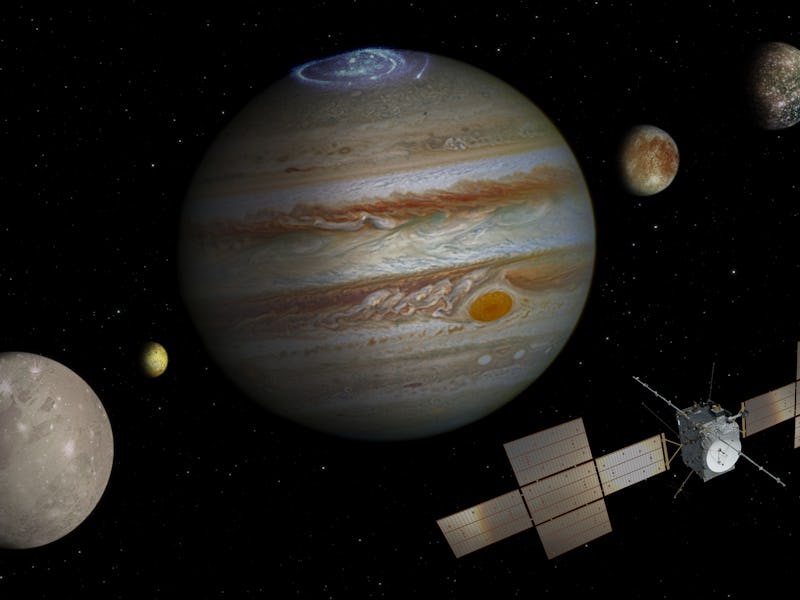ESA's New Juice Mission Might Finally Uncover Jupiter's Hidden Secrets
Three of the four Galilean moons around Jupiter might have oceans beneath their ice.

The frozen moons of Jupiter will reveal their secrets to the Jupiter Icy Moons Explorer (Juice) in 2031, when the mission is predicted to reach the gas giant and kicks off a new exploration into the nature of life in the Solar System.
Like its name suggests, the mission from the European Space Agency (ESA) will look at three icy Jovian moons that might be habitable: Ganymede, Europa, and Callisto. Juice will build upon what’s already known about their compositions and surfaces, explore questions about thermal vents that might exist at the bottom of their alien oceans, and explore how the Solar System works, how Jupiter influences its planet-sized moons, and if life could have emerged somewhere else other than Earth.
April 2023: Juice launch date
ESA is currently preparing the spacecraft for its long journey to the outer Solar System. Juice will launch from French Guiana, at Europe’s Spaceport in Kourou, aboard a European Ariane 5 launcher.
After an April 2023 launch, Juice will begin its eight-year trip through space.
Juice is presented to the media in Toulouse, France on January 20, 2023.
What type of mission is Juice?
Juice will study three out of the four Galilean moons, famously spotted centuries ago as Galileo Galilei beheld Jupiter.
Ganymede, Europa, and Callisto are thought to have oceans of liquid water beneath their icy surfaces. And it’s possible that thanks to Jupiter’s powerful influence, they all form a mini-version of our Solar System. And if life sprouted a few planets away, perhaps it could have formed there as well.
“This environment we want to further investigate,” Cyril Cavel, Juice Project Manager at Airbus in France, says in a January 2023 video from BBC News. Their oceans might sustain the conditions necessary for primitive lifeforms to emerge, Cavel also says.
“Humanity always poses itself a question: Are we alone in the Universe?” says Manuela Baroni, Juice assembly, integration, and test engineer at ESA, in a video from the space agency. To answer that question, Baroni says, scientists first need to know if other worlds have the right life-friendly conditions.
Beyond the habitability question, data from these moons can also be useful to exoplanet scientists who may one day parse through Juice’s observations for anything that could complement their queries about the planets around other stars.
Juice mission timeline
During its first eight years, Juice will tour the inner Solar System. Its journey to Jupiter will feature flybys of Venus, Earth, and the Earth-Moon system.
In July 2031, Juice will reach Jupiter. And sometime around the 2032 New Year, Juice will enter orbit around the planet.
Juice will then kick its mission into high gear, touring the Jovian system and paying special attention to the icy moons. Europa, Ganymede, and Callisto will also receive flybys. The tour will culminate with an orbital insertion around Ganymede.
The Galileo spacecraft captured this view of Ganymede on June 26, 1996.
Ganymede will be the spacecraft’s final stop. It’s earned this status because it’s the only moon in the Solar System to have its own magnetic field, a shield of sorts that might make Ganymede more hospitable to life forms. This field creates auroras, too, which appear thanks to the oxygen in its atmosphere. It’s also the Solar System’s largest moon and boasts a surface area greater than the Eurasian continent, according to NASA.
Instruments of Juice
The spacecraft will use 10 instruments to learn about the Jupiter system.
- JANUS: An optical camera system
- UVS: UV imaging Spectrograph
- MAJIS: Moons and Jupiter Imaging Spectrometer
- SWI: Sub-millimeter Wave Instrument
- GALA: Ganymede Laser Altimeter
- RIME: Radar for Icy Moons Exploration
- J-MAG: A magnetometer instrument for Juice
- PEP: Particle Environment Package
- RPWI: Radio & Plasma Wave Investigation
- 3GM: Gravity & Geophysics of Jupiter and Galilean Moons
How long is the Juice mission?
Juice will be considered a success if it completes four years of science work. But if it performs well, it might get an extension. NASA’s current Juno mission to Jupiter, for instance, is on its extended mission that is set to last through September 2025.
This article was originally published on